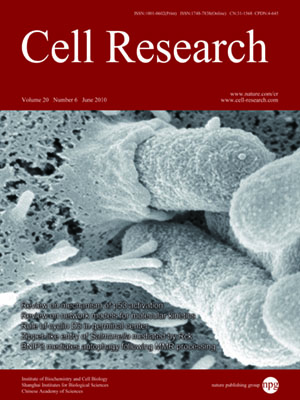
Volume 20, No 6, Jun 2010
ISSN: 1001-0602
EISSN: 1748-7838 2018
impact factor 17.848*
(Clarivate Analytics, 2019)
Volume 20 Issue 6, June 2010: 713-727
ORIGINAL ARTICLES
Characterization of kinesin-like proteins in silkworm posterior silkgland cells
Qiao Wang1, Junlin Teng1, Birong Shen1, Wei Zhang1, Yige Guo1, Xiaolei Su1, Chuanxi Zhang3, Albert CH Yu4 and Jianguo Chen1,2
1The Key Laboratory of Cell Proliferation and Differentiation of Ministry of Education, The State Key Laboratory of Bio-membrane and Membrane Bio-engineering, College of Life Sciences, Peking University, Beijing 100871, China
2The Center for Theoretical Biology, Peking University, Beijing 100871, China
3Institute of Insect Sciences, Zhejiang University, Hangzhou 310029, China
4Department of Neurobiology, Neuroscience Research Institute, School of Basic Medical Sciences, The Key Laboratory for Neuroscience (Ministry of Education and Ministry of Public Health), Peking University, Beijing 100191, China
Correspondence: Junlin Teng, Jianguo Chen,(junlinteng@pku.edu.cn; chenjg@pku.edu.cn)
Kinesins are microtubule-based motors involved in various intracellular transports. Neurons, flagellated cells, and pigment cells have been traditionally used as model systems to study the cellular functions of kinesins. Here, we report silkworm posterior silkgland (PSG), specialized cells with an extensive endomembrane system for intracellular transport and efficient secretion of fibroin, as a novel model for kinesin study. To investigate kinesin-driven intracellular transport in PSG cells, we cloned five silkworm kinesin-like proteins (KLPs), BmKinesin-1, BmKinesin-6, BmKinesin-7, BmKinesin-13, and BmKinesin-14A. We determined their expression patterns by relative real-time PCR and western blotting. Immunofluorescence microscopy verified their colocalization with microtubules. By combining pull-down assays, LC-MS/MS, and western blotting analysis, we identified many potential cargoes of BmKinesin-1 in PSG, including fibroin-containing granules and exuperantia-associated ribonucleoprotein (RNP) complexes. Moreover, BmKinesin-13 overexpression disrupted the microtubule network in BmN cells, which is consistent with a role of Kinesin-13 in regulating microtubule dynamics in other organisms. On the basis of these results, we concluded that PSG might have advantages in elucidating mechanisms of intracellular transport in secretory tissues and could serve as a potential model for kinesin studies.
Kinesins are microtubule-based motors involved in various intracellular transports. Neurons, flagellated cells, and pigment cells have been traditionally used as model systems to study the cellular functions of kinesins. Here, we report silkworm posterior
FULL TEXT | PDF
Browse 2336


